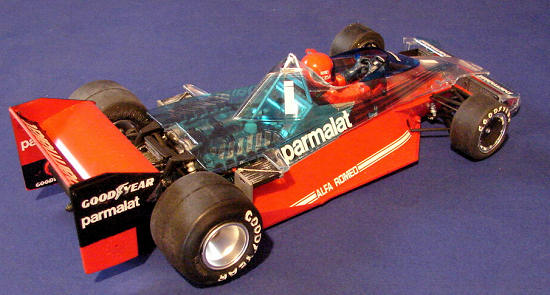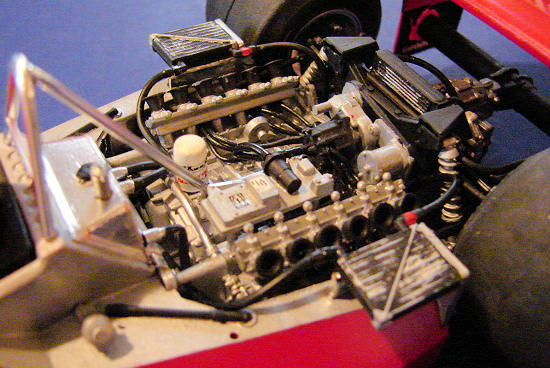
Tamiya 1/20 Brabham Alfa Romeo
BT46
| KIT #: | 20050 |
| PRICE: | $ |
| DECALS: | Two options |
| REVIEWER: | Mark Hiott |
| NOTES: |
Clear cowl, with driver figure |

| HISTORY |
The Brabham
BT46 was a Formula One racing car, designed by Gordon Murray for the Brabham
team, for the 1978 Formula One season. The car featured several radical design
elements, the most obvious of which was the use of flat panel heat exchangers on
the bodywork of the car to replace conventional water and oil radiators. The
concept did not work in practice and was removed before the car’s race debut,
never to be seen again. The cars, powered by a flat-12 Alfa Romeo engine, raced
competitively with modified nose-mounted radiators for most of the year.
 Alfa-Romeo’s
sportscar-derived flat-12 engine had a capacity of 2995 cc. The engine featured
a cast magnesium engine block with aluminium crankcase and magnesium or
aluminium cylinder heads. There were four gear driven valves per cylinder. In
Formula One form it delivered about 520 bhp at 12,000 rpm, about 50 bhp more
than the Cosworth DFV engines used by most teams, as well as a peak 324 lb/ft of
torque. However, the power
came at the expense of greater size, increased fuel and oil consumption and
about 40kg more weight. The car used a revised and lighter version of the
6-speed gearbox designed for the BT45B. Brabham designed the gearbox casing,
which was cast by Alfa Romeo and used Hewland gears.
Alfa-Romeo’s
sportscar-derived flat-12 engine had a capacity of 2995 cc. The engine featured
a cast magnesium engine block with aluminium crankcase and magnesium or
aluminium cylinder heads. There were four gear driven valves per cylinder. In
Formula One form it delivered about 520 bhp at 12,000 rpm, about 50 bhp more
than the Cosworth DFV engines used by most teams, as well as a peak 324 lb/ft of
torque. However, the power
came at the expense of greater size, increased fuel and oil consumption and
about 40kg more weight. The car used a revised and lighter version of the
6-speed gearbox designed for the BT45B. Brabham designed the gearbox casing,
which was cast by Alfa Romeo and used Hewland gears.
The BT46s
debuted at the third race of the 1978 season, the South African Grand Prix on 4
March 1978, with the revised nose mounted radiators. The cars were immediately
competitive, although reliability was suspect. After the winning debut and
subsequent withdrawal of the BT46B “fan car” at the Swedish Grand Prix the
Brabham team completed the season with the standard BT46s. Niki Lauda winning
the Italian Grand Prix in the standard car, albeit after Mario Andretti and
Gilles Villeneuve were penalised a minute for jumping the second race start
after Ronnie Peterson’s fatal accident at the first start. The BT46 appeared for
the last time in the Formula One World Championship at the first round of the
1979 season in the hands of Nelson Piquet. Niki Lauda also used the car to
qualify for that race, as the new BT48 was proving troublesome, although he did
race the new car. Piquet retired on the first lap after a multi-car collision
that wrecked the BT46.
 The "B"
variant of the car, also known as the "fan car", was introduced at the 1978
Swedish Grand Prix as a counter to the dominant ground effect Lotus 79. The
BT46B generated an immense level of downforce by means of a fan, claimed to be
for increased cooling, but which also extracted air from beneath the car. The
car only raced once in this configuration in the Formula One World
Championship... when Niki Lauda won the 1978 Swedish Grand Prix at Anderstorp.
The concept was declared illegal by the
The "B"
variant of the car, also known as the "fan car", was introduced at the 1978
Swedish Grand Prix as a counter to the dominant ground effect Lotus 79. The
BT46B generated an immense level of downforce by means of a fan, claimed to be
for increased cooling, but which also extracted air from beneath the car. The
car only raced once in this configuration in the Formula One World
Championship... when Niki Lauda won the 1978 Swedish Grand Prix at Anderstorp.
The concept was declared illegal by the
(Another
variation on the theme was produced later in the season. Like the BT46B, the
BT46C removed the radiators from the front wing assembly leaving a clean
aerodynamic wing and moving the center of gravity further back again. The
standard radiators were replaced by units mounted behind the front wheels out of
the airstream in a region of positive pressure. The BT46C only ran in practice
for the 1978 Austrian Grand Prix. The drivers complained of reduced revs and
straight line speed. It was not used in the race and never appeared again.)
| THE KIT |
 If you've
ever built a Tamiya F1 kit, what's in the box should look familiar to you. The
only difference is that this is a "clear cowl" version that allows one to show
off all the neat stuff inside. Molded in several colors, with a nice set of
chrome wheels, a solid plastic cowl is not included. The molding is crisp and
the kit shows a good amount of detail. A clear blue-tinted windscreen is also a
nice touch. Wires are included for the engine and hoses for the oil coolers.
If you've
ever built a Tamiya F1 kit, what's in the box should look familiar to you. The
only difference is that this is a "clear cowl" version that allows one to show
off all the neat stuff inside. Molded in several colors, with a nice set of
chrome wheels, a solid plastic cowl is not included. The molding is crisp and
the kit shows a good amount of detail. A clear blue-tinted windscreen is also a
nice touch. Wires are included for the engine and hoses for the oil coolers.
The
instructions are an 8 page, 17 step booklet and, in typical Tamiya fashion, show
photos of the assembly process in the margins. A parts layout is also included.
there are color callout, but no paint numbers are given.
The decals are the star of the kit. Well printed, they include both solid and translucent decals for the clear cowl. Versions are given for cars driven by either Watson or Lauda.
| CONSTRUCTION |
Tamiya
kits really have the best fit of any car kits. I didn't have any trouble at any
point during construction. Construction begins
 with the
engine. You will have to install the ignition wires during the process. The
block was assembled and then painted as a whole. Once done, all the various bits
were attached. Don't forget the decal for the oil filter. The transaxle is then
assembled and attached to the back of the engine. When attaching the exhaust,
attach part #A18 and A19 (the rear pipes) first, then parts #A8 and A9 (front
pipes).
with the
engine. You will have to install the ignition wires during the process. The
block was assembled and then painted as a whole. Once done, all the various bits
were attached. Don't forget the decal for the oil filter. The transaxle is then
assembled and attached to the back of the engine. When attaching the exhaust,
attach part #A18 and A19 (the rear pipes) first, then parts #A8 and A9 (front
pipes).
Moving on to the chassis, I installed the front lower suspension and the lower
body panel before painting the body. It makes taking care of any seams easier.
The remainder of the chassis was assembled as per the instructions. The engine
is then attached to the rear of the chassis.
The tires and rear wing were assembled, but left off until after decaling. The tires use, the now standard, poly caps to hold them in place. The front ones are inserted in the brake rotors and the rears are in the wheels themselves.
| COLORS & MARKINGS |
The
instructions contain color callouts for all the assembly steps. I followed most
of them with few variations. The engine was painted MM Steel with a MM Gunmetal
transaxle. The suspension was painted MM Flat Black. The chassis was pai nted
MM Bright Red with MM chrome where called for. The Goodyear logos on the tires
were painted with MM acrylic flat white. (this being an older kit, the rub-on
logos were not included)
nted
MM Bright Red with MM chrome where called for. The Goodyear logos on the tires
were painted with MM acrylic flat white. (this being an older kit, the rub-on
logos were not included)
Decals are included for either Watson or Lauda, I chose to do Lauda's car. The
only real differences are the car number and the drivers helmet. The decals went
down with no trouble, although I was worried about the translucent decals. Now
that I look at the car I noticed that I installed the front number too low, it
should be up on the windscreen.
The
last bits installed were the mirrors, rear wing and tires.
| CONCLUSIONS |
Another great Formula 1 kit from Tamiya. It is a bit complicated for a first
time builder, but if you have a couple Tamiya kits under your belt, this is a
great addition to your F1 collection.
| REFERENCES |
 Internet
for the history.
Internet
for the history.
March 2012
If you would like your product reviewed fairly and fairly quickly, please contact the editor or see other details in the Note to Contributors.